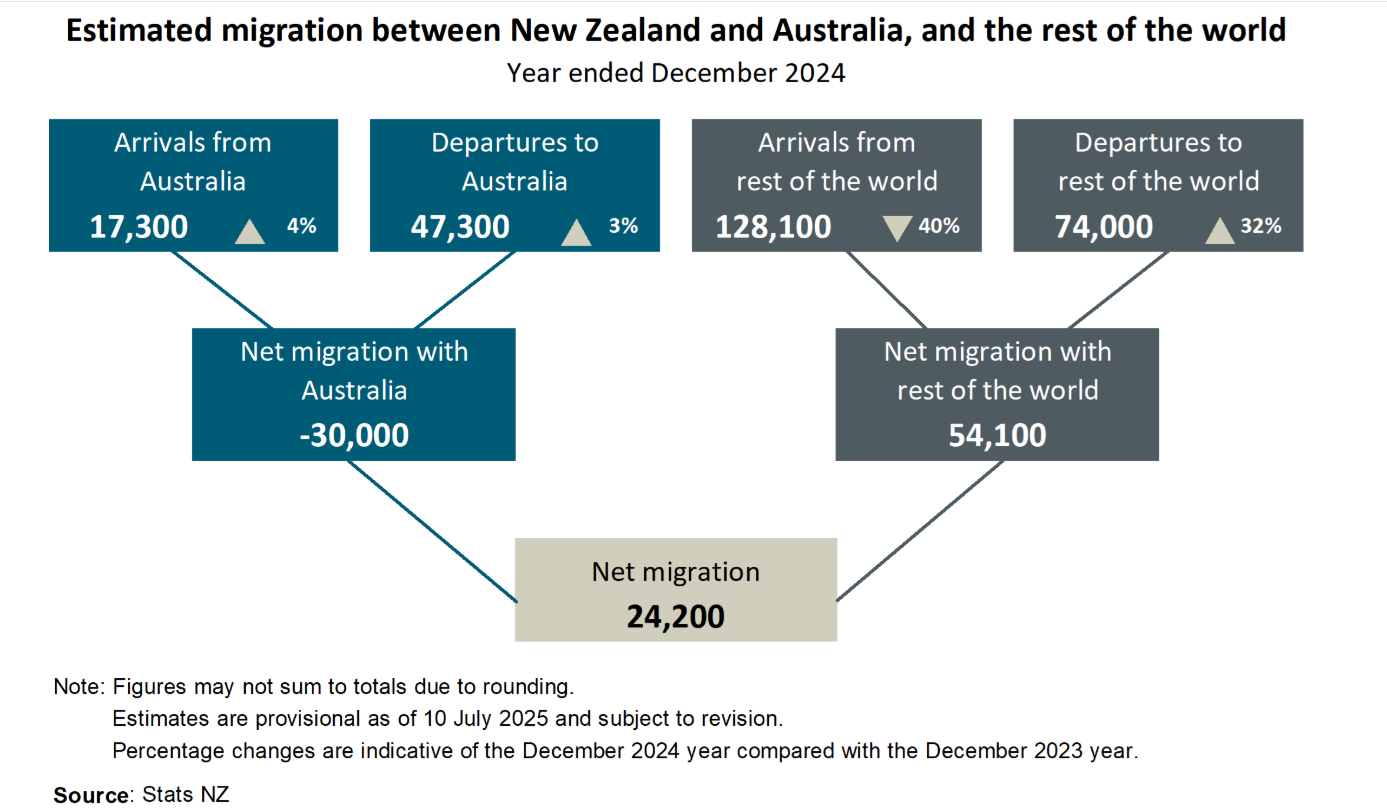New Zealand's net migration loss to Australia reaches 12-year high

New Zealand recorded a net migration loss of 30,000 people to Australia in the year to December 2024 – the largest calendar-year loss since 2012, according to provisional estimates from Stats NZ.
“The net migration loss from New Zealand to Australia in 2024 was similar to the loss of 29,400 in 2023,” said Sarah Drake, international migration statistics spokesperson at Stats NZ.
“The loss in 2024 is the largest for a calendar year since 2012, but below the record loss of 43,700 in the March 2012 year.”
Migration to Australia driven by NZ citizens
Of the 47,300 people who moved from New Zealand to Australia in 2024, 85% were New Zealand citizens – continuing a long-standing trend.
“New Zealand citizens were the main driver of trans-Tasman migration flows in 2024,” Drake said in a media release.
That figure is slightly higher than 2023, when New Zealand citizens made up 84% of those moving to Australia and 61% of returnees.
In contrast, just 17,300 people migrated to New Zealand from Australia in 2024.

Young and overseas-born migrants fuel departures
Stats NZ data shows that more than half of all New Zealand-citizen departures – 51% – were aged 20 to 39, the most mobile demographic.
Significantly, 35% of New Zealand citizens moving to Australia in 2024 were born overseas, higher than the national population average of 29% in 2023.
Australia still the top destination
Australia accounted for 58% of all New Zealand-citizen migrant departures in 2024. While that is lower than the 2012 peak (77%), it remains the most popular destination, based on data going back to 1979.
Net migration gain from rest of world narrows
Despite the losses to Australia, New Zealand still recorded a net migration gain of 54,100 people from the rest of the world in 2024. However, that is down sharply from the record 157,300 gain in 2023.
Between 2004 and 2019, net migration gains from countries excluding Australia averaged 46,100 annually.
ASB: Economic weakness driving migration trends
ASB senior economist Mark Smith (pictured) said that net permanent and long-term (PLT) migration inflows have fallen to a 2½-year low, largely due to slowing arrivals and record-high departures.
“Annual net permanent and long-term migration inflows fell to a 2½ year low, driven by slowing arrivals of non-NZ citizens and record PLT departures,” Smith said in an economic note. “This is reflective of the relatively weak position of the NZ economy.”
Smith said total annual PLT departures reached 124,500, with NZ citizen departures hitting a record 71,200.
“Annual net outflows of NZ citizens were at a record high 46,800 persons, driven by strengthening migration departures.”
Migration slump may ease inflation pressure
Smith said a lower net immigration rate could dampen medium-term inflation, especially with New Zealand’s economy already operating below capacity.
“Low net immigration will likely dampen medium-term inflationary pressures, supporting a lower OCR,” he said.
ASB now expects a 25bp cut to the Official Cash Rate (OCR), reaching 3% by August, with downside risks if migration continues to weaken.
Visitor arrivals plateau as tourism recovery stalls
Monthly visitor numbers in May eased 0.9% seasonally adjusted, with total annual arrivals at 3.37 million, still about 14% below pre-COVID highs.
“The challenge will be to try and grow the sector at a time of heightened global uncertainty,” Smith said.
The ASB economist flagged geopolitical risks and trade tensions – particularly involving China and the US – as factors that could further impact tourism and migration patterns.



